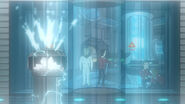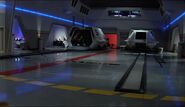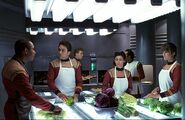The Constitution II class1 was a Federation Starship-class heavy cruiser operated by Starfleet from the late 23rd to the middle of the 24th century.
History[]
Development and implementation[]
"That's why you're staying aboard."

Scotty examining the schematics for the Enterprise-A
Known at the time simply as a refit of the original Constitution-class, the Constitution II was conceived initially as part of an 18-month redesign and retrofit that came about during the early 2270s under the direction of Captain Will Decker and Commander Montgomery Scott. (Star Trek: The Motion Picture, Star Trek VI: The Undiscovered Country; PIC: "The Bounty")

The Enterprise following its refit
The refitting of the USS Enterprise produced an almost totally new vessel, replacing virtually every major system, with very few officers who were fully rated on the new design. The USS Enterprise continued to serve in its prominent role even before the refit was fully completed, and when it was put to task in defending the Federation from the external threat posed of the V'Ger probe. (Star Trek: The Motion Picture)
2280s[]
In the early-2280s, the Enterprise itself was reassigned as a training vessel.
Prior to real-time experience commanding the Enterprise, Starfleet Academy trainees used a planet-side bridge simulator based on the ship, which was identified as an Enterprise-class Mark IV bridge simulator. (Star Trek II: The Wrath of Khan)
Following the heavy structural damage caused by Khan Noonien Singh during battle with the USS Reliant, and the arrival the dawn of a new age for starships with the introduction of the Excelsior-class USS Excelsior, Starfleet Command felt that the ship would not be suitable for another refit due to the fact that "the Enterprise is twenty years old," and it was felt that "her day is over." (Star Trek III: The Search for Spock)

USS Enterprise-A shortly after its launch
By 2286 at least three ships of this class were in service, including the USS Enterprise-A – which was commissioned at the San Francisco Fleet Yards on stardate 8442.5 – and two other ships. (Star Trek IV: The Voyage Home)
Shortly after the Enterprise-A's launch, it was found in Captain Scott's shakedown cruise report, that in his opinion, "I think this new ship was put together by monkeys," and "she's got a fine engine, but half the doors won't open." He further admitted to Captain Kirk, "All I can say is they don't make 'em like they used to." (Star Trek V: The Final Frontier)
2290s[]
Many newer Constitution II-class starships were in service in 2293, as a task force consisting of the Constitution II-class USS Ahwahnee, USS Eagle, USS Emden, USS Endeavour, and USS Potemkin was assembled to assist with the rescuing of James T. Kirk, and Leonard McCoy from Klingon captivity as part of Operation Retrieve. (Star Trek VI: The Undiscovered Country)
24th century[]
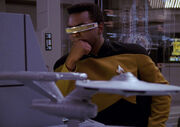
Model of a modified Constitution II appearing in Drafting Room 5
A model of a 2270s version of this ship present in a holographic simulation of Drafting Room 5 at Utopia Planitia Fleet Yards had the warp nacelles rotated 90 degrees and included additional hatches along both sides of the saucer. (TNG: "Booby Trap")
A small number of Constitution II-class ships presumably remained in service through the 24th century, with at least one ship having engaged the Borg at Battle of Wolf 359. (TNG: "The Best of Both Worlds, Part II")
Legacy[]
By 2401, the Constitution II-class had been completely phased out; while the USS Enterprise-A, which had been decommissioned in 2293 to make way for the new Excelsior-class USS Enterprise-B, was stored on display at the Fleet Museum. (PIC: "The Bounty")
While it was explicitly stated that the original Enterprise itself was a refit, there were presumably later vessels of this class that were scratch built using this design, including the Enterprise-A.
Technical data[]
Physical arrangement[]

Aft view of the USS Enterprise-A
The Constitution II-class featured the saucer section-engineering section-warp nacelle layout common to most Starfleet vessels. (Star Trek: The Motion Picture; etc.) In retrospect, Jack Crusher was personally fond of this class, commenting on the design's "perfectly clean retro lines." (PIC: "The Bounty")
Propulsion systems[]

|

|
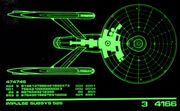
|
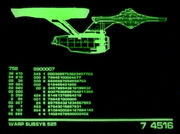
|
The main sub-light drive on Constitution II-class starships was an impulse drive, located at the back of the saucer/primary hull section of the ship which allowed the ship the capable of velocities at least warp factor 0.8. The warp engines were capable of at least warp 7. (Star Trek: The Motion Picture, Star Trek V: The Final Frontier; TNG-R: "The Naked Now", "Datalore", "The Last Outpost" display graphic)
Tactical systems[]

A Constitution II vessel fires its forward phasers in the 2270s
After their redesign in the 2270s, Constitution II-class ships, phaser power was increased by channeling energy directly from the main engines. The phasers would be automatically cut off if the engines ever went into anti-matter imbalance. Photon torpedoes were not affected by this deficiency. (Star Trek: The Motion Picture)

Torpedo launcher
Constitution class vessels in the 2270s and onward had two forward firing torpedo launchers located on the base of the neck on the primary hull, though each tube could fire at least two torpedoes per load. (Star Trek II: The Wrath of Khan; Star Trek III: The Search for Spock)
During the 2280s, a Klingon Bird-of-Prey was said to be "out-gunned, ten to one" by a Constitution II-class battle cruiser. (Star Trek III: The Search for Spock)
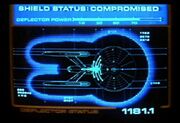
Deflector status display
The Constitution II-class starship had a powerful deflector screens and shields.
In the 2280s, a Constitution II-class starship needed 13.5 seconds to lower and raise their shields when taking a shuttlecraft on board via its tractor beam. Piloting the shuttle manually reduced this time significantly. (Star Trek V: The Final Frontier) During yellow alerts, defense fields were activated to offer basic protection to the main bridge. (Star Trek II: The Wrath of Khan)

Torpedo manifest
According to Mr. Scott's Guide to the Enterprise (p. 14), the deflector shields of the configuration in the 2270s, were redesigned as a massive replicator system, projecting an invisible hull layer, molecularly identical to the diburnium-osmium alloy used to build the Kalandan outpost seen in the episode TOS: "That Which Survives".
Interior design[]

Deck configuration
In the 2270s, the color scheme varied on ships, changing from a beige tone, with red accents to a predominate overall gray/dark gray toward the 2280s. (Star Trek: The Motion Picture – Star Trek VI: The Undiscovered Country)
Bridge[]
As was typical for Starfleet vessels, the bridge of the Constitution II-class was located on Deck 1 of the primary hull, atop the saucer section. A large viewscreen was located at the front of the bridge. There were two turbolifts to the bridge.
The bridge underwent only a few minor modifications from that point until the destruction of the ship in 2285. The bridge of the USS Enterprise-A, commissioned one year later (in 2286), had mainly cosmetic differences at launch, but by 2287, it had been drastically upgraded to reflect the advances made in computer control technology. The lighter color scheme of the original Enterprise-A bridges had made room for a darker, more militaristic look. (Star Trek II: The Wrath of Khan; Star Trek IV: The Voyage Home; Star Trek V: The Final Frontier; Star Trek VI: The Undiscovered Country)
Despite the fact that the Enterprise-A had used all touch-interfaces in Star Trek V: The Final Frontier, director Nicholas Meyer insisted that some of the consoles on the bridge be fitted with physical dials and gauges for Star Trek VI: The Undiscovered Country. (citation needed • edit)
Main engineering[]
Main engineering was from where the ship's warp was controlled. All thrust and power systems were primarily controlled from this site, and it is also where the main dilithium crystal reactor/warp core was located for most of the ship's life.
During the 2270s, the interior design of the engineering section was drastically upgraded from the previous design, featuring a vertical warp core and the horizontal warp plasma conduits to the nacelle conduits nor being below the warp core. The core could be accessed through on Deck 15. An isolation door could be brought down to separate the core from the rest of the ship. (Star Trek: The Motion Picture, Star Trek II: The Wrath of Khan, Star Trek VI: The Undiscovered Country)
The main energizers were critical engineering components; without them, the ship was only able to function on auxiliary and impulse power. In some cases, the main energizers could be bypassed to allow for restoration of partial main power. (Star Trek II: The Wrath of Khan)
Reactor room[]
The reactor room was a chamber located within main engineering and was responsible for controlling the warp reactor. Due to the potential of radiation exposure, the reactor room was isolated from the rest of engineering, located adjacent to the vertical warp core. During normal conditions, engineers did not require special protection. The room was shielded from the rest of engineering via a transparent partition and entryway in order to contain radiation leaks. The circular doorway which served as the room's entrance could be manually controlled by a nearby console when radiation containment was active. The room contained several system monitors. (Star Trek II: The Wrath of Khan) The reactor room was featured in the training holodeck program The Needs of the Many during the early 2380s. (LD: "I, Excretus")
The reactor room was not named on screen, but was named in the script. [1]
Transport and cargo[]
Airlocks[]

Airlock staging area in the 2270s
Constitution II-class starships possessed a number of airlocks permitting direct physical access to the ship. On the ship configuration from the 2270s, one airlock was located at the aft of Deck 1 on top of the saucer section. (Star Trek: The Motion Picture)
Yet another airlock was located on the ventral port-side saucer section, concealed by sliding hull plates. It was accessed through a staging area. Four spacesuit lockers lined one wall, each containing one suit, providing enough to clothe a standard party of four. A small, locked arms cabinet held phasers; communicators, tricorders, translators, and outerwear were contained in a separate cabinet on another wall. (Star Trek: The Motion Picture)
An identical set of doors was located on the starboard side; most published blueprints suggest yet another docking port here as well.
The next set of airlocks were located on the port and starboard sides of the torpedo bays. The final set were located on the port and starboard sides of the secondary hull at the midline. (Star Trek: The Motion Picture; Star Trek II: The Wrath of Khan) These airlocks opened into the ship's main cargo bay. There was also a "gangway"-style airlock on the port edge of the saucer section. (Star Trek: The Motion Picture)
Located on the upper surface of the saucer section of the refitted Enterprise were numerous small hatches used for entrance and egress during extra-vehicular activities. (Kirk, Spock, Decker, McCoy, and the Ilia probe used one of these hatches to leave the ship when they arrived at V'Ger's "core".) (Star Trek: The Motion Picture)
Cargo bay[]
The configuration of the 2270s Constitution II-class starship featured a new landing bay design. A wide range of Starfleet and Federation craft could utilize this state-of-the-art landing facility. Alcoves on either side of the landing bay provided storage for work bees. (Star Trek: The Motion Picture)
Shuttlebay[]
The shuttlebay was located at the rear of the ship's engineering section. Unlike its predecessor, the shuttlebay of the Enterprise-A was a separate and distinct area from the cargo bay. Normally, a tractor beam guided the shuttle to a landing. A large net barricade could be erected to capture an incoming shuttle which was landing too fast or otherwise disabled. (Star Trek V: The Final Frontier)
Torpedo bays[]
The torpedo bay was on Deck 13. It was much more automated than on the previous Enterprise, and the torpedo room itself was smaller and enclosed. It had varying degrees of automation or could as well be manually-loaded bays. (Star Trek II: The Wrath of Khan; Star Trek VI: The Undiscovered Country)
Although only two distinct forward torpedo tubes are seen on the refit USS Enterprise, torpedo bays labeled 3 and 4 were seen in Star Trek II: The Wrath of Khan.
Transporter rooms[]
Aboard the Constitution II-class vessels of the 2270s and beyond, the transporter operator stood within an enclosed control pod, which had a floor-to-ceiling transparent aluminum panel through which he or she could view the transport platform. This panel served to shield the operator from the effects of any cumulative radiations emitted by the new transporter machinery, a side effect of the more powerful system. (Star Trek: The Motion Picture)
Turbolifts and Jefferies tubes[]
The turbolift shafts were triangular in shape. In addition to the normal corridors, there were full-height Jefferies tubes in the engineering hull. (Star Trek V: The Final Frontier)
A well-known blooper occurs in Star Trek V: The Final Frontier when Kirk, Spock, and McCoy rocket past a number of decks while in the turboshaft, labeled inconsistently with 78 as the highest value, when the Constitution II had about 21 decks (with deck 1 at the top). (Star Trek V: The Final Frontier (Special Edition))
Medical facilities[]
With the class refit of the 2270s, the medical facilities of the Constitution II-class starship were considerably updated, or in the words of Dr. Leonard McCoy they're "like working in a damned computer center." (Star Trek: The Motion Picture)
New micro-diagnostic tables were capable of fully analyzing the humanoid body at the sub-cellular level, offering the physician a total understanding of the patient's status. (Star Trek: The Motion Picture)
By 2293, the sickbay on Constitution II-class starships was redesigned yet again. (Star Trek VI: The Undiscovered Country)
Crew accommodations[]
Brig[]

the brig of the Constitution II class in the 2280s
The brig was located in the bowels of the engineering hull. It was designed to be escape-proof, certified so by Captain Spock Despite this, Montgomery Scott was able to free Kirk, Spock and McCoy from captivity by blowing through the back wall from the outside. (Star Trek V: The Final Frontier)
Galley[]
Meals were prepared in a galley. (Star Trek VI: The Undiscovered Country)
The replicator prop from the Star Trek: The Next Generation senior officers' quarters was seen in Captain Kirk's quarters during The Undiscovered Country and contained a set of dishes and flatware. It is not entirely clear whether this device was meant to function like a 24th century replicator as well.
Officers' lounge and mess[]

Officers' lounge privacy area on a Constitution II-class vessel of the 2270s

The officers' mess aboard the USS Enterprise-A
The officers' lounge was located in the aft superstructure beneath the bridge after the 2270s refit. (Star Trek: The Motion Picture)
The officers had a private dining hall in the saucer section, which was often used to entertain guests.
Located within the primary hull of the Constitution II-class starship, the officers' mess was a long room, lined by several large windows that seemed to face out into space or an image of a starfield. (Star Trek VI: The Undiscovered Country)
The officers' mess aboard the Enterprise-A was seen only in the sixth film and was a redress of the observation lounge of the USS Enterprise-D from Star Trek: The Next Generation.
Recreation deck[]
The recreation deck was one large room in the aft section of the starship's saucer section furnished off-duty personnel with a wide variety of recreational games and entertainment. At the front of the room was an immense, wall-mounted viewing screen. Beneath this was an information display alcove; five small screens exhibited a history of selected vessels called Enterprise. A raised platform in the center of the lower-level floor featured a diversity of electronic entertainment. (Star Trek: The Motion Picture)
According to the script, "The Recreation Deck is one of the largest areas on the ship, several deck levels high, a part of one wall consisting of picture windows, through which can be seen sections of the drydock structure outside. On another wall is a large viewer, on which was just shown the Klingon transmission. Leading off and away from this deck area are what are obviously other specific recreation areas – gymnasiums, food centers, game rooms, lounges, etc."
Forward observation room[]
The forward observation room was located in the middle front of the saucer and an additional lounge was still at the back of deck 2. An emergency transmitter was also located in the observation room. (Star Trek V: The Final Frontier)
The forward observation lounge was intended to be centered on the forward edge of the Enterprise saucer and a visual effect (not developed due to budget limitations) would have shown the whole ship approaching the camera until the room and its occupants were visible through the three large windows.
Officers' quarters[]
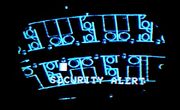
Layout of crew quarters
Officers' quarters were located throughout the saucer section on decks 4 or 5. (Star Trek: The Motion Picture)

Officers's quarters in the 2270s
On Constitution II-class vessels in the 2270s, rooms of the senior officers were composed of two areas which were separated by a retractable partition. The room's entrance opened into the living area. A library computer terminal and work desk were provided here.
The other half of the stateroom was a sleeping area, which held a single large bed that could double as a sofa during off-duty relaxation. A transparent door led into the bathroom area, which included a sonic shower. (Star Trek: The Motion Picture)
By the 2290s, the size of officers' quarters was reduced to one large room and crewmen were housed in dormitories with bunk beds due to an increased crew compliment in Constitution II-class starships.
Officers had crew quarters similar to those on the previous Enterprise. Enlisted crew members were required to bunk together. As many as eight crew members were assigned to a room, each assigned a storage locker. (Star Trek VI: The Undiscovered Country)
This graphic depicting the location of Spock's quarters was taken from Franz Joseph's Star Fleet Technical Manual, "Security Section" page, which represented the pre-refit design. [2]
Ships commissioned[]
- Certain2
- USS Ahwahnee (NCC-2048)
- USS Eagle (NCC-956)
- USS Emden (NCC-1856)
- USS Endeavour (NCC-1895)
- USS Enterprise (NCC-1701; refit)
- USS Enterprise (NCC-1701-A)
- USS Korolev (NCC-2014)
- USS Potemkin (NCC-1657; refit)
- Unnamed
- Uncertain
- USS Kongo (NCC-1710)
- USS Merrimac (NCC-1715)
- USS Olympia
- USS Yorktown
Appendices[]
Appearances[]
- Star Trek films
- TNG:
- "The Naked Now" (display graphic}
- "The Last Outpost" (display graphic)
- "Lonely Among Us" (model)
- "The Battle" (model)
- "Hide And Q" (model)
- "Haven" (model)
- "The Big Goodbye" (model)
- "Datalore" (display graphic)
- "Too Short A Season" (model)
- "Coming of Age" (wall display)
- "The Neutral Zone" (model)
- "The Bonding" (model)
- "Booby Trap" (model)
- "The Best of Both Worlds, Part II" (wreckage)
- DS9:
- "The Nagus" (display graphic)
- "Homefront" (model)
- "Paradise Lost" (model)
- VOY: "In the Flesh" (wall display)
- ST: "Ephraim and Dot"
- PIC:
- "The Next Generation" (poster art)
- "The Bounty"
- "Võx"
- "The Last Generation"
- LD: "I, Excretus" (holographic recreation)
Background information[]
Name []
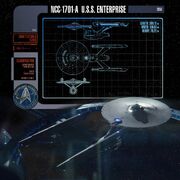
Production fact sheet
The "Constitution-II" designation first appeared in print in the concurrently published USS Enterprise Officer's Manual (p. 147, by Geoffrey Mandel and Doug Drexler), and the Star Trek Spaceflight Chronology (p. 180, by Rick Sternbach) reference books from 1980. At that particular point in time the term was in competition with the concurrent, but equally unofficial Enterprise-class designation. (see: here) Both Mandel and Drexler incidentally, worked four decades later as production staff on the third season of Star Trek: Picard during which the designation became officially adopted by their superior on the show, Production Designer Dave Blass.
The Star Trek: Picard Logs first proposed that by the early 25th century, with the introduction of the Constitution III-class, the refit-Constitution-class ships had been retroactively re-classified as Constitution II-class starships by Starfleet. [3]
In spite of being twice identified on screen as a "Constitution-class", first in Scotty's paper diagram in Star Trek VI: The Undiscovered Country and later in quote spoken by Jack Crusher at the top of this article in PIC: "The Bounty", the name was later officially applied to the Enterprise-A in a production fact sheet (shown to right) shared by Dave Blass. [4] It has made the designation "official" as Blass was at the time bonafide production staff, which neither of the two 1980 reference books were, they not considered as such by the Star Trek franchise. (Star Trek: The Magazine Volume 2, Issue 11, p. 71)
Because Blass' tweet falls within the guidelines of the Memory Alpha:Resource policy, the name is used here to better differentiate between the refit from the original design.
Ships of the class []
The Eagle, Korolev, Emden, Endeavour, and Ahwahnee, with their respective registry numbers, were all derived from the Operation Retrieve mission charts artwork, seen in the Star Trek VI: The Undiscovered Country (Special Edition) DVD, where they were represented by Constitution II-class icons. Michael Okuda, who created the mission charts, indicated they were intended to be of this class,
"If I recall correctly, the charts visible on film/video listed only ship names and registry numbers. One can probably glean some class designations from the ship icons in the diagrams. I don't have the original art handy (I think it's archived on Syquest disks, which I don't have the ability to read, even if I could find the disks themselves), but I recall giving the info to Bjo Trimble, and I'm pretty sure she used most of it in her revised Star Trek Concordance. I might note that some of the ship registry numbers came from Greg Jein's interpretation of the starship chart in Commodore Stone's office in "Shore Leave" (TOS) [sic]. Other registry numbers came from Franz Joseph's Star Fleet Technical Manual or his Starship blueprints. In still other cases, the ships and/or numbers did not come from either source, but were consistent with some fleet status charts I did elsewhere on the Enterprise-A in Star Trek VI. (In other words, there's something that just about everyone will disagree with, but I also hoped that there would be at least something that almost everyone would agree with.) I should also point out that I prepared several charts for the rescue briefing scene, and that not all of them ended up in the final cut of the film. I don't recall which ones were used, or which ones ended up unseen. I do seem to recall that there was at least one chart that had quite a number of registries – mostly, I recall, from FJ's work – that ended up unused." [5]
Dimensions[]
As had been the case with the original Constitution-class (until Star Trek: Discovery's 2019 episode "Brother" that is), the 1,000 feet length of the 2270s Constitution II-class has never been canonically established on screen either, instead generally gleaned from the 1991 reference book, Star Trek: The Next Generation Technical Manual, where it was propagated to the public at large. The Manual itself was based on the internal document Star Trek: The Next Generation Writers' Technical Manual in which Andrew Probert had provided dimensions for most of the more prominent Starfleet vessels until then established in the live-action franchise. In fact, it was Probert himself who took the initiative to introduce the new dimension when he co-designed the 2270s Enterprise for The Motion Picture, "I wanted to actually go larger on the size of the ship, not realizing at the time that the Enterprise was originally in drydock for a refitting. Richard felt we should stay with the proportions that we had inherited from Matt Jefferies and Joe Jennings, when they'd designed it for Star Trek: Phase II. So with that as our starting basis. I lengthened the ship to a thousand feet, just a few feet longer than it was, and enlarged the saucer, eventually adding an updated superstructure to the top and bottom of it." [6]
In turn, Visual Effects Art Director Nilo Rodis adopted Probert's dimension as a yardstick for the multitude of newly-introduced starships designs on the size comparison production art, he had created for Star Trek III: The Search for Spock, published in a Cinefantastique article (Vol 17 #3/4, 1987, p. 77) almost a decade later, and where the size was actually disclosed to the general public for the very first time. This was not a whimsical act on Rodis' part; since studio models were almost never build in scale to each other, visual effects compositors at Industrial Light & Magic needed some sort of a reference dimensional framework in order for them to take the relative sizes of the newly designed ships into account, when editing their ship effects footage if more that one appeared in a shot, for the interior Spacedock One scenes in particular. Rodis' dimensions for the new ships (and spacedock) were reciprocally adopted by Probert for the later Writer's Technical Manual.
Studio models[]
Saucer separation[]
A saucer separation capability for the Constitution II-class' immediate predecessor was already suggested as early as the second season of Star Trek: The Original Series in the original script of its episode "The Apple", but was never produced as no Original Series script has ever actually called for one. The capability was however envisioned by the producers, "Designed to operate separately from the rest of the ship, the saucer therefore contains all elements necessary for independent operation." (The Making of Star Trek, p. 171) The intent even made it into the official series' internal writer's guide, The Star Trek Guide (third revision, page 15 of the supplement and generally dubbed the "Writer's Bible"), where the saucer section was described to be "in fact a completely self-sustaining unit which can detach itself from the galaxy drive units and operate on atomic impulse power for short range solar system exploration." [7]
The original saucer separation intent was reconfirmed years later on two occasions, when efforts were underway to revitalize the live-action franchise. Production Illustrator for Star Trek: Planet of Titans, Ralph McQuarrie, stated on several of the concept drawings he had created for a newly conceived Enterprise, "The saucer of the Enterprise (which was detachable) ends up in the shroud. They meet the aliens and had a dramatic finale. These two images are of the Enterprise saucer in the shroud. (…) The disc of the Enterprise would separate from the rest of the ship to land on the surface of planets." [8] The sketches McQuarrie referred to, of the independently operating saucer section, were published in The Art of Ralph McQuarrie (pp. 124-129). The second occasion occurred when Star Trek: Phase II Producer Robert Goodwin reported in a progress memo dated 8 September 1977, "Meanwhile we're having a new model of the Enterprise constructed, with the added bonus of a saucer section which can separate from the engine nacelles, should such a maneuver be a necessary part of some story. This capacity of the Enterprise was described in The Making of Star Trek, although it was never utilized in the first series." (Starlog, issue 11, p. 39)

|

|
Yet another saucer separation sequence was envisioned by Andrew Probert in 1979 when script treatments for Phase II's successor, The Motion Picture, were in flux. During a lull in script development Probert came up with an alternative scene in which V'Ger releases a Klingon K't'inga-class battle cruiser. Upon re-materialization the Klingons true to their nature immediately attack the Enterprise. During the battle Kirk is forced to perform a maneuver akin to that of William T. Riker in "The Best of Both Worlds, Part II". Douglas Trumbull liked the idea and had Probert draw up color storyboards to show the sequence. Some of the storyboards were published in Star Trek: The Magazine Volume 1, Issue 22, p. 132, and in The Art of Star Trek, pages 198-199. Probert's concept was not entirely a flight of fancy as the actual studio model, in line with Goodwin's prior memo annotation, was constructed in such a way that a saucer separation could easily be filmed if the need arose – contrary to the Original Series filming model, which was not. (Star Trek: The Next Generation Companion, 3rd ed., p. 9) Probert himself remarked in this regard, "The Enterprise was always designed to separate from the Engineering section. I knew about this when I did Star Trek: The Motion Picture. And if you look at the bottom of Kirk's Enterprise [note: late 2260s configuration], you'll notice two triangular items, which are two of the landing feet for the saucer. Regardless of whether it was Matt Jefferies' original intention or not, it's sort of the way that "Trekdom" or "Star Trek lore" has labeled those features. So taking my cue from that for Star Trek: The Motion Picture, I placed four landing legs in the bottom of the Enterprise and created a very specific separation line on the dorsal." (Star Trek: The Next Generation USS Enterprise NCC-1701-D Blueprints, booklet, p. 8)
In the early drafts of Star Trek: The Motion Picture, the Enterprise was to separate the saucer. The 2006 Star Trek: Ships of the Line calendar includes a picture of a separated Constitution II-class ship, engaging Klingons – or possibly a Klingon ship flown by the Romulans – in battle.
Apocrypha[]
The 2270s version of the Constitution II-class was still in service in 2409 as a cruiser in the video game Star Trek Online (though the TOS configuration can be purchased into the game as well). The class has also inspired three 24th/25th century successors: the Excalibur (β), Vesper (β), and Exeter (β)-classes. The TOS configuration comes with retrofit fore and aft phasers, which are the TV-correct blue phasers. The Exeter-class, which also can be purchased, comes with the ability to fire photon torpedoes which can hunt down cloaked targets. The Discovery configuration, available through "Infinity Promotions", is classified as a "flight deck carrier" with two full squadrons of tactical flyers.
External links[]
- Enterprise class at Memory Beta, the wiki for licensed Star Trek works
- Designing The Motion Picture Enterprise at Forgotten Trek – article on the design of the 2270s Enterprise for The Motion Picture
- Redesigning the Enterprise at the Federation Starship Datalink
- The Enterprise Refit of 2271 at Ex Astris Scientia – analysis of the several modifications performed on the Constitution-class













